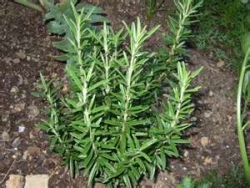Growing Rosemary
Common name for Rosmarinus officinalis, a hardy evergreen sub-shrub grown chiefly for its aromatic leaves which are used in culinary seasoning and which yield an oil once used in medicine. Small light blue flowers are borne in April or May, in loose clusters that spring from the leaf axils. The foliage is white and woolly on the under side and dark and shiny above. Plants can grow to a height of 6 feet and last for years if given winter protection.
Rosemary prefers dry, well-drained soil and in the South and Pacific Coast States, where soil is dry and rocky, they are planted as hedges. There is also a low-growing or prostrate variety.
Rosemary grows well with occasional watering, and does much better where the soil is alkaline. All varieties prefer full sun and most can tolerate slightly shady areas.
Rosemary propagates easily by taking six inch long stem cuttings that are stuck in a mixture of sand, loam, and leaf mold, ideally in a controlled environment such as a greenhouse or cold frame.
Growing Cultures
Outdoors, containers, hydroponics.
Plant Height
Rosemary plants grow to a height of 36 to 48 inches (90 – 120cm).
Plant Spacing
Rosemary plants should be spaced 18 to 24 inches (45 – 60cm) apart.
Preferred pH Range
Rosemary will grow in a pH range between 6.0 (mildly acidic) and 8.5 (alkaline) with a preferred range between 6.0 and 7.5.
Propagation
Sow indoors in sunny location or under plant grow lights eight weeks before last frost. Rosemary propagates well via stem cuttings.
Seed Germination Period
15 to 25 days.
Seeds Per Gram (Approximate)
1,000.
Soil Requirements
Light and well-draining.
Alternative Growing Media
Soilless potting mixes, perlite, vermiculite, rockwool, coco peat, Oasis foam.
Time From Seed to Saleable Plant
Sow in seed flats 22 weeks before sale in 10cm diameter pots. Seeds to finished plugs, 12 weeks; plugs to saleable plants, 10 weeks.
Sun & Lighting Requirements
Rosemary grown outdoors prefers full sun.
USDA Hardiness
7a to 10b.
Water Requirements
Average water needs. Water on a regular schedule, do not overwater.
Potential Pests & Diseases
Whitefly, scale, mealybug. Powdery mildew.
Special Notes
Drought tolerant, suitable for xeriscaping. Rosemary is known to attract bees, butterflies and birds. Fragrant flowers. Suitable for containers.
